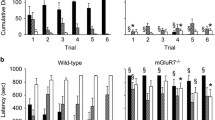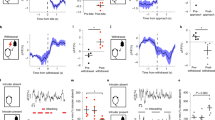Abstract
Rationale
Male CB1KO mice exhibit stronger aggressive responses than wild-type mice.
Objective
This study was designed to examine the role of cannabinoid CB2r in social and aggressive behavior.
Methods
The social interaction test and resident–intruder paradigm were performed in mice lacking CB2r (CB2KO) and in wild-type (WT) littermates. The effects of the CB2r selective agonist JWH133 (1 and 2 mg/kg) on aggression were also evaluated in Oncins France 1 (OF1) mice. Gene expression analyses of monoamine oxidase-A (MAO-A), catechol-o-methyltransferase (COMT), 5-hydroxytryptamine transporter (5-HTT), and 5-HT1B receptor (5HT1Br) in the dorsal raphe nuclei (DR) and the amygdala (AMY) were carried out using real-time PCR.
Results
Group-housed CB2KO mice exhibited higher levels of aggression in the social interaction test and displayed more aggression than resident WT mice. Isolation increased aggressive behavior in WT mice but did not affect CB2KO animals; however, the latter mice exhibited higher levels of social interaction with their WT counterparts. MAO-A and 5-HTT gene expression was significantly higher in grouped CB2KO mice. The expression of 5HT1Br, COMT, and MAO-A in the AMY was more pronounced in CB2KO mice than in WT counterparts. Acute administration of the CB2 agonist JWH133 significantly reduced the level of aggression in aggressive isolated OF1 mice, an effect that decreased after pretreatment with the CB2 receptor antagonist AM630.
Conclusion
Our results suggest that CB2r is implicated in social interaction and aggressive behavior and deserves further consideration as a potential new target for the management of aggression.






Similar content being viewed by others
References
Bhakta SG, Zhang JP, Malhotra AK (2012) The COMT Met158 allele and violence in schizophrenia: a meta-analysis. Schizophr Res 140:192–197. doi:10.1016/j.schres.2012.06.026
Boles SM, Miotto K (2003) Substance abuse and violence—a review of the literature. Aggress Violent Behav 8:155–174. doi:10.1016/S1359-1789(01)00057-X
Brain PF, Benton D, Childs G, Parmigiani S (1981) The effect of the type of opponent in test of murine aggression. Behav Process 6:319–327. doi:10.1016/0376-6357(81)90049-8
Brenes JC, Fornaguera J (2009) The effect of chronic fluoxetine on social isolation-induced changes on sucrose consumption, immobility behavior, and on serotonin and dopamine function in hippocampus and ventral striatum. Behav Brain Res 198:199–205. doi:10.1016/j.bbr.2008.10.036
Buckley NE, McCoy KL, Mezey E, Bonner T, Zimmer A, Felder CC, Glass M, Zimmer A (2000) Immunomodulation by cannabinoids is absent in mice deficient for the cannabinoid CB(2) receptor. Eur J Pharmacol 396:141–149. doi:10.1016/S0014-2999(00)00211-9
Carder B, Olson J (1972) Marihuana and shock induced aggression in rats. Physiol Behav 8:599–602. doi:10.1016/0031-9384(72)90081-9
Carlini EA, Gonzales C (1972) Aggressive behavior induced by marihuana compounds and by amphetamine in rats previously made dependent on morphine. Experimentia 28:542–544
Carlini EA, Lindsey CJ, Mustry RE, Monti JM (1976) Marihuana aggressiveness in REM-sleep-deprived rats: neurochemical and neurophysiological correlates. In: Braude MC, Szara S (eds) The pharmacology of marihuana. Raven, New York, pp 515–530
Davidson RJ (2000) Dysfunction in the neural circuitry of emotion regulation—a possible prelude to violence. Science 289:591–594. doi:10.1126/science.289.5479.591
Duke AA, Bègue L, Bell R, Eisenlohr-Moul T (2013) Revisiting the serotonin-aggression relation in humans: a meta-analysis. Psychol Bull 139:1148–1172. doi:10.1037/a0031544
El Marroun H, Hudziak JJ, Tiemeier H, Creemers H, Steegers EA, Jaddoe VW, Hofman A, Verhulst FC, van den Brink W, Huizink AC (2012) Intrauterine cannabis exposure leads to more aggressive behavior and attention problems in 18-month-old girls. Drug Alcohol Depend 118:470–474. doi:10.1016/j.drugalcdep.2011.03.004
García-Gutiérrez MS, Manzanares J (2011) Overexpression of CB2 cannabinoid receptors decreased vulnerability to anxiety and impaired anxiolytic action of alprazolam in mice. J Psychopharmacol 25:111–120. doi:10.1177/0269881110379507
García-Gutiérrez MS, Pérez-Ortiz JM, Gutiérrez-Adán A, Manzanares J (2010) Depression-resistant endophenotype in mice overexpressing cannabinoid CB(2) receptors. Br J Pharmacol 160:1773–1784. doi:10.1111/j.1476-5381.2010.00819.x
García-Gutiérrez MS, García-Bueno B, Zoppi S, Leza JC, Manzanares J (2012) Chronic blockade of cannabinoid CB2 receptors induces anxiolytic-like actions associated with alterations in GABA(A) receptors. Br J Pharmacol 165:951–964. doi:10.1111/j.1476-5381.2011.01625.x
Ginsberg SD, Che S, Hashim A, Zavadil J, Cancro R, Lee SH, Petkova E, Sershen HW, Volavka J (2011) Differential regulation of catechol-O-methyltransferase expression in a mouse model of aggression. Brain Struct Funct 216:347–356. doi:10.1007/s00429-011-0315-z
Gong JP, Onaivi ES, Ishiguro H, Liu QR, Tagliaferro PA, Brusco A, Uhl GR (2006) Cannabinoid CB2 receptors: immunohistochemical localization in rat brain. Brain Res 1071:10–23. doi:10.1016/j.brainres.2005.11.035
Haller J, Bakos N, Szirmay M, Ledent C, Freund TF (2002) The effects of genetic and pharmacological blockade of the CB1 cannabinoid receptor on anxiety. Eur J Neurosci 16:1395–1398. doi:10.1046/j.1460-9568.2002.02192.x
La Porta C, Bura SA, Aracil-Fernández A, Manzanares J, Maldonado R (2013) Role of CB1 and CB2 cannabinoid receptors in the development of joint pain induced by monosodium iodoacetate. Pain 154:160–174. doi:10.1016/j.pain.2012.10.009
Maccarrone M, Valverde O, Barbaccia ML, Castañé A, Maldonado R, Ledent C, Parmentier M, Finazzi-Agrò A (2002) Age-related changes of anandamide metabolism in CB1 cannabinoid receptor knockout mice: correlation with behaviour. Eur J Neurosci 15:1178–1186. doi:10.1046/j.1460-9568.2002.01957.x
Maier T, Guell M, Serrano L (2009) Correlation of mRNA and protein in complex biological samples. FEBS Lett 583(24):3966–3973. doi:10.1016/j.febslet.2009.10.036
Malick JB (1979) The pharmacology of isolation-induced aggressive behavior in mice. Curr Rev Psychopharmacol 5:1–27
Márquez C, Poirier GL, Cordero MI, Larsen MH, Groner A, Marquis J, Magistretti PJ, Trono D, Sandi C (2013) Peripuberty stress leads to abnormal aggression, altered amygdala and orbitofrontal reactivity and increased prefrontal MAOA gene expression. Transl Psychiatry 3, e216. doi:10.1038/tp.2012.144
Marsden CA, King MV, Fone KC (2011) Influence of social isolation in the rat on serotonergic function and memory—relevance to models of schizophrenia and the role of 5-HT(6) receptors. Neuropharmacology 61:400–407. doi:10.1016/j.neuropharm.2011.03.003
Martin M, Ledent C, Parmentier M, Maldonado R, Valverde O (2002) Involvement of CB1 cannabinoid receptors in emotional behaviour. Psychopharmacology 159:379–387. doi:10.1007/s00213-001-0946-5
Miczek KA (1978) Delta 9-tetrahydrocannabinol: antiaggressive effects in mice, rats, and squirrel monkeys. Science 199(4336):1459–1461
Miczek KA, O’Donnell JM (1978) Intruder-evoked aggression in isolated and nonisolated mice: effects of psychomotor stimulants and L-dopa. Psychopharmacology 57:47–55
Navarrete F, Perez-Ortiz JM, Manzanares J (2012) Cannabinoid CB2 receptor-mediated regulation of impulsive-like behaviour in DBA/2 mice. Br J Pharmacol 165:260–273. doi:10.1111/j.1476-5381.2011.01542.x
Onaivi ES (2006) Neuropsychobiological evidence for the functional presence and expression of cannabinoid CB2 receptors in the brain. Neuropsychobiology 54:231–246. doi:10.1159/000100778
Onaivi ES, Ishiguro H, Gong JP, Patel S, Meozzi PA, Myers L, Perchuk A, Mora Z, Tagliaferro PA, Gardner E, Brusco A, Akinshola BE, Hope B, Lujilde J, Inada T, Iwasaki S, Macharia D, Teasenfitz L, Arinami T, Uhl GR (2008) Brain neuronal CB2 cannabinoid receptors in drug abuse and depression: from mice to human subjects. PLoS ONE 3, e1640. doi:10.1196/annals.1432.036
Ortega-Alvaro A, Aracil-Fernández A, García-Gutiérrez MS, Navarrete F, Manzanares J (2011) Deletion of CB2 cannabinoid receptor induces schizophrenia-related behaviors in mice. Neuropsychopharmacology 36:1489–1504. doi:10.1038/npp.2011.34
Proietto J, Rissanen A, Harp JB, Erondu N, Yu Q, Suryawanshi S, Jones ME, Johnson-Levonas AO, Heymsfield SB, Kaufman KD, Amatruda JM (2010) A clinical trial assessing the safety and efficacy of the CB1R inverse agonist taranabant in obese and overweight patients: low-dose study. Int J Obes 34:1243–1254. doi:10.1038/ijo.2010.38
Raine A (2002) Biosocial studies of antisocial and violent behavior in children and adults: a review. J Abnorm Child Psychol 30:311–326
Rodríguez-Arias M, Miñarro J, Aguilar MA, Pinazo J, Simón VM (1998) Effects of risperidone and SCH 23390 on isolation-induced aggression in male mice. Eur Neuropsychopharmacol 8:95–103. doi:10.1016/S0924-977X(97)00051-5
Rodríguez-Arias M, Maldonado C, Vidal-Infer A, Guerri C, Aguilar MA, Miñarro J (2011) Intermittent ethanol exposure increases long-lasting behavioral and neurochemical effects of MDMA in adolescent mice. Psychopharmacology 218:429–442. doi:10.1007/s00213-011-2329-x
Rodriguez-Arias M, Navarrete F, Daza-Losada M, Navarro D, Aguilar MA, Berbel P, Miñarro J, Manzanares J (2013) CB1 cannabinoid receptor-mediated aggressive behavior. Neuropharmacology 75:172–180. doi:10.1016/j.neuropharm.2013.07.013
Rydén E, Thase ME, Straht D, Aberg-Wistedt A, Bejerot S, Landen M (2009) A history of childhood attention-deficit hyperactivity disorder (ADHD) impacts clinical outcome in adult bipolar patients regardless of current ADHD. Acta Psychiatr Scand 120:239–246. doi:10.1111/j.1600-0447.2009.01399.x
Schmittgen TD, Zakrajsek BA, Mills AG, Gorn V, Singer MJ, Reed MW (2000) Quantitative reverse transcription-polymerase chain reaction to study mRNA decay: comparison of endpoint and real-time methods. Anal Biochem 285:194–204. doi:10.1006/abio.2000.4753
Scott AL, Bortolato M, Chen K, Shih JC (2008) Novel monoamine oxidase A knock out mice with human-like spontaneous mutation. Neuroreport 19:739–743. doi:10.1097/WNR.0b013e3282fd6e88
Singh JP, Volavka J, Czobor P, Van Dorn RA (2012) A meta-analysis of the Val158Met COMT polymorphism and violent behavior in schizophrenia. PLoS One 7, e43423. doi:10.1371/journal.pone.0043423
Smoothy R, Brain PF, Berry MS, Haug M (1986) Alcohol and social behaviour in group-housed female mice. Physiol Behav 37:689–694. doi:10.1016/0031-9384(86)90173-3
Soyka M, Zill P, Koller G, Samochowiec A, Grzywacz A, Preuss UW (2015) Val158Met COMT polymorphism and risk of aggression in alcohol dependence. Addict Biol. doi:10.1111/adb.12098
Stetler DA, Davis C, Leavitt K, Schriger I, Benson K, Bhakta S, Wang LC, Oben C, Watters M, Haghnegahdar T, Bortolato M (2014) Association of low-activity MAOA allelic variants with violent crime in incarcerated offenders. J Psychiatr Res 58:69–75. doi:10.1016/j.jpsychires.2014.07.006
Sulcova E, Mechoula R, Fride E (1998) Biphasic effects of anandamide. Pharmacol Biochem Behav 59:347–353. doi:10.1016/S0091-3057(97)00422-X
Takahashi A, Quadros IM, de Almeida RM, Miczek KA (2011) Brain serotonin receptors and transporters: initiation vs. termination of escalated aggression. Psychopharmacology 213:183–212. doi:10.1007/s00213-010-2000-y
Takahashi A, Quadros IM, de Almeida RM, Miczek KA (2012) Behavioral and pharmacogenetics of aggressive behavior. Curr Top Behav Neurosci Behav Pharmacogenet Aggress Behav 12:76–138. doi:10.1007/7854_2011_191
Ueki S, Fujiwara M, Ogawa N (1972) Mouse-killing behavior (muricide) induced by D9-tetrahydrocannabinol in the rat. Physiol Behav 9:585–587. doi:10.1016/0031-9384(72)90016-9
Urigüen L, Pérez-Rial S, Ledent C, Palomo T, Manzanares J (2004) Impaired action of anxiolytic drugs in mice deficient in cannabinoid CB1 receptors. Neuropharmacology 46:966–973. doi:10.1016/j.neuropharm.2004.01.003
Valverde O, Torrens M (2012) CB1 receptor-deficient mice as a model for depression. Neuroscience 204:193–206. doi:10.1016/j.neuroscience.2011.09.031
Valzelli L (1985) Animal models of behavioral pathology and violent aggression. Methods Find Exp Clin Pharmacol 4:189–193
Van Sickle MD, Duncan M, Kingsley PJ, Mouihate A, Urbani P, Mackie K, Stella N, Makriyannis A, Piomelli D, Davison JS, Marnett LJ, Di Marzo V, Pittman QJ, Patel KD, Sharkey KA (2005) Identification and functional characterization of brainstem cannabinoid CB2 receptors. Science 310:329–332. doi:10.1126/science.1115740
Volavka J (2013) Violence in schizophrenia and bipolar disorder. Psychiatr Danub 25:24–33
Acknowledgments
This work was supported by the following research grants: Ministerio de Ciencia e Innovación (SAF2011-23420 awarded to Jorge Manzanares; SAF2010-15793 awarded to Olga Valverde); Ministerio de Economía y Competitividad, Dirección General de Investigación (PSI2011-24762 awarded to PI Jose Miñarro); Generalidad Valenciana, Consejería de Educación (PROMETEO/2009/072 awarded to PI Jose Miñarro); Generalitat de Catalunya (2009SGR684 awarded to Olga Valverde); Instituto de Salud “Carlos III” (FIS); Redes Telemáticas de Investigación Cooperativa en Salud (RETICS); Red de Trastornos Adictivos (RTA); fondos FEDER (RD06/0001/1004 and RD12/0028/0019 awarded to PI Jorge Manzanares, RD06/001/0016 and RD12/0028/0005 awarded to PI Jose Miñarro, and RD06/001/1001 and RD12/0028/0024 awarded to PI Olga Valverde).

Author information
Authors and Affiliations
Corresponding author
Additional information
Highlights
- Grouped CB2KO mice show higher levels of offensive aggression than WT mice in the social interaction test.
- CB2KO mice show higher levels of offensive aggression than WT mice in the resident intruder paradigm.
- COMT, MAO-A, 5-HTT and 5HT1Br mRNA levels differ in WT and CB2KO mice.
- Administration of JWH133 decreases the level of aggression in OF1 mice.
- Treatment with JWH133 normalizes alterations of MAO-A and COMT gene expression in aggressive isolated mice.
Electronic supplementary material
Below is the link to the electronic supplementary material.
ESM 1
(DOCX 176 kb)
Rights and permissions
About this article
Cite this article
Rodríguez-Arias, M., Navarrete, F., Blanco-Gandia, M.C. et al. Role of CB2 receptors in social and aggressive behavior in male mice. Psychopharmacology 232, 3019–3031 (2015). https://doi.org/10.1007/s00213-015-3939-5
Received:
Accepted:
Published:
Issue Date:
DOI: https://doi.org/10.1007/s00213-015-3939-5




